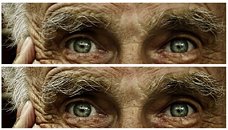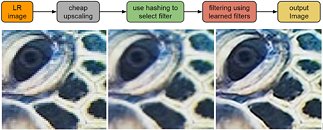Saturday, November 26th 2016

"Zoom and Enhance" to Become a Reality Thanks to Machine Learning
The one phrase from television that makes IT people and creative professionals cringe the most is "zoom and enhance" - the notion that you zoom into a digital image and, at the push of a button, it converts a pixellated image into something with details - which lets CSI catch the bad guys. Up until now, this has been laughably impossible. Images are made up of dots called pixels, and the more pixels you have, the more details you can have in your image (resolution). Zooming into images eventually shows you a colorful checkerboard that's proud of its identity.
Google is tapping into machine-learning, in an attempt to change this. The company has reportedly come up with a machine-learning technique that attempts to reconstruct details in low-resolution images. Google is calling this RAISR (rapid and accurate image super-resolution). The technology works with the software learning "edges" of a picture (portions of the image with drastic changes in color and brightness gradients), and attempts to reconstruct them. What makes this different from conventional super-sampling methods is its machine-learning component. A low-resolution image is studied by the machine to invent an upscaling method most effective for the image, in-situ. While its application in law-enforcement is tricky, and will only become a reality when a reasonably high court of law sets a spectacular precedent; this technology could have commercial applications in up-scaling low-resolution movies to new formats such as 4K Ultra HD, and perhaps even 8K.
Source:
Google
Google is tapping into machine-learning, in an attempt to change this. The company has reportedly come up with a machine-learning technique that attempts to reconstruct details in low-resolution images. Google is calling this RAISR (rapid and accurate image super-resolution). The technology works with the software learning "edges" of a picture (portions of the image with drastic changes in color and brightness gradients), and attempts to reconstruct them. What makes this different from conventional super-sampling methods is its machine-learning component. A low-resolution image is studied by the machine to invent an upscaling method most effective for the image, in-situ. While its application in law-enforcement is tricky, and will only become a reality when a reasonably high court of law sets a spectacular precedent; this technology could have commercial applications in up-scaling low-resolution movies to new formats such as 4K Ultra HD, and perhaps even 8K.



28 Comments on "Zoom and Enhance" to Become a Reality Thanks to Machine Learning
Given that, frankly, I wouldn't trust it at all.
www.benvista.com/photozoompro/examples
I've also used their S-Spline filter to optimize System Shock 2 cutscenes...
rejzor.wordpress.com/2015/05/26/system-shock-2-high-definition-cutscenes/
Clearly, you can't pull non existent information out of your ass, but advanced prediction algorithms can certainly elevate the image details far beyond high quality filters like Bicubic or Lanczos.
:D
Accelerating Machine Learning - AMD.
Reference - www.forbes.com/sites/aarontilley/2016/11/15/google-taps-amd-for-accelerating-machine-learning-in-the-cloud/#1dd64f7e4181